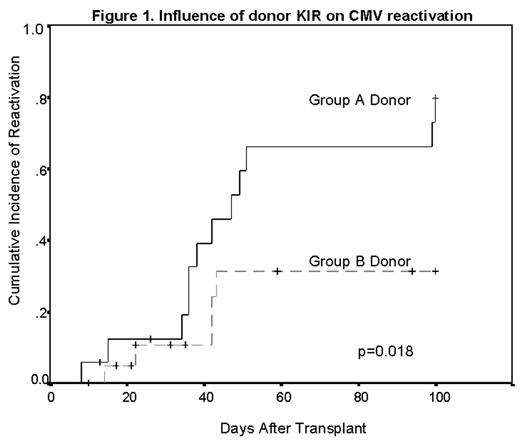Abstract
Background
CMV reactivation is the commonest viral complication following allogeneic stem cell transplantation (SCT) and is a direct consequence of immunodeficiency. Natural killer (NK) and T-cells are the primary effector populations that suppress CMV replication. Killer immunoglobulin-like receptors (KIRs) are expressed on the surface of NK cells and T-cell subsets. Inhibitory KIRs have specificity for defined alleles of class I HLA and deliver an inhibitory signal to the cell. Activating KIRs bind weakly to HLA molecules and their true ligands remain unknown. KIR genes are polymorphic. Two broad haplotypes exist which differ in the number of activatory KIR genes that they contain. Haplotype A has 1 activatory KIR gene whereas haplotype B contains additional activatory genes.
Methods
We studied 107 patients undergoing allogeneic SCT at 3 UK Institutions to evaluate the effect of activating KIRs on CMV reactivation. Two thirds received standard myeloablative conditioning with TBI/Cy or Bu/Cy. One third received non-myeloablative conditioning. Recipient/donor CMV sero-status was determined by ELISA. Reactivation was defined as two successive PCR assays detecting >400 copies/ml. KIR genotyping was performed by PCR-SSP.
Results
In CMV seropositive recipients, the CMV reactivation rate was 50% in transplants from sibling donors and 64% in transplants from unrelated or HLA non-identical donors. In sibling transplants where both donor and recipient were CMV seropositive and the donor was homozygous for KIR Haplotype A (group A) the CMV reactivation rate was 65% .In contrast if the donor possessed at least one KIR haplotype B (group B) the reactivation rate was reduced to 27.5% (p=0.014). The protective effect of group B donors was seen only in patients who received a myeloablative non-T-depleted transplant. Here, the reactivation rate was 70.6% (12 from 17) when transplanted from a group A donor compared with 23.8% (5 from 21) when transplanted from a group B donor (p=0.0039). If a group B donor was used no reactivation was seen after 41 days, whereas in transplants from group A donors the risk of reactivation continued until day 100 (figure 1,p=0.018). The donor KIR genotype did not influence CMV reactivation rates in patients who received T-depleted grafts from sibling, unrelated or haploidentical donors.
Conclusion
In T-cell replete sibling donor transplants the use of a donor with multiple activating KIRs significantly reduces the risk of CMV reactivation when both donor and recipient are CMV seropositive. This is the first direct evidence of activating KIRs exerting a controlling effect on CMV in humans.
Author notes
Corresponding author


This feature is available to Subscribers Only
Sign In or Create an Account Close Modal